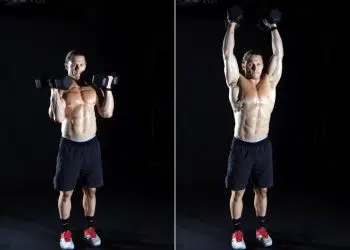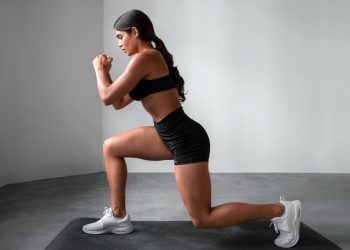Pull-ups get all the glory when it comes to the best bodyweight back-building exercise, while inverted rows are often left underappreciated.
The inverted row is a stellar back exercise to hone in your whole upper back, including the lats, traps, rhomboids, and rear delts. One benefit that makes it a better back exercise than pull-ups is its scalability — it’s suitable for all ages. Inverted rows are ideal for all, whether you are a young athlete or a 70-year-old grandpa. On the other hand, pull-ups are still unattainable for a large population.
In This Exercise:
- Target Muscles Group: All back muscles (Rhomboids, Erector Spinae, Lattisimus Dorsi, Trapezius)
- Type: Strength
- Mechanics: Compound
- Equipment: Smith machine, weighted vest or weight plate
- Difficulty: Intermediate/Advanced
Who Should Do Weighted Inverted Rows?
The weighted inverted row is one of the best exercises that you can do to build a bigger and stronger back. It’s a compound exercise that primarily targets the back muscles but also the biceps and forearms as a secondary muscle group.
Perhaps the unweighted version is enough for most people. However, once you reach a point when it gets easy to perform 15-20 reps of the hardest variation of the inverted row, this is when you should be advancing toward the weighted version of inverted rows.
Inverted rows have always been used as an excellent workout finisher or an accessory movement to add volume to the back workout. But when you add external weight to the bodyweight version, you take the back training to the next level.
Weighted Inverted Row — Muscle Worked
The weighted inverted row is a compound movement that targets the following muscles:
Level Up Your Fitness: Join our 💪 strong community in Fitness Volt Newsletter. Get daily inspiration, expert-backed workouts, nutrition tips, the latest in strength sports, and the support you need to reach your goals. Subscribe for free!
- Latissimus Dorsi: You might know it as ‘lats.’ Latissimus dorsi is a large muscle group that runs from the upper arm to the lower back. It is responsible for the adduction of the arm. It’s the same muscle that provides that V taper aesthetic back — prefer narrow grip inverted row when you want to emphasize more on the lat development.
- Rhomboids: These are the muscle groups located in the upper back, beneath the trapezius and between the shoulder blades. The main task of the rhomboid muscle is to keep the scapula in place. It assists in scapular stabilization, scapula retraction, and shoulder extension, and improves posture by pulling the shoulder blades together towards the spine. Furthermore, strong and stable rhomboids reduce the chances of injuries.
- Trapezius: Also known as ‘traps.’ It is a large muscle group located in the middle of your upper back. It runs from the base of the skull to the middle of the back. The trapezius muscle is responsible for shoulder elevation, scapular retraction, and head and neck extension.
- Rear deltoids: It is the rear part of your shoulders that plays an important role in pulling the arms backward and rotating them outward. Emphasizing the posterior deltoid helps you develop cannonball delts.
- Biceps and forearms: These muscles play a supportive role during inverted rows. They act as a synergistic muscle group, working in conjunction with the primary muscle groups.
- Core and erector spinae: Weighted inverted row especially emphasizes torso strength and stability as it will be working hard to maintain the correct posture throughout the movement.
How to do Weighted Inverted Row
- Set up the Smith machine bar to a height where you can do a full inverted pull-up.
- Then, place a bench in front of the Smith machine far enough to where you can rest your feet on it while performing the pull-up.
- Now, put on your weighted vest or grab a small weight plate to place on your torso.
- Bend down beneath the bar and grip it slightly wider than shoulder-width distance apart.
- Place the plate on your mid/upper torso and then elevate your feet on the bench. If you have a weighted vest, you can perform the inverted pull-up as you would normally.
- Pull yourself up to the bar and contract your back muscles while exhaling.
- Then, lower yourself back down until your arms are extended while inhaling.
- Repeat for the desired number of reps.
Form Tips
Below are some form tips to make the most of the weighted inverted row:
- Starting position: It’s not necessary to keep the body parallel to the ground. You can position your feet on the floor to reduce the resistance. You can bring your feet forward or backward to adjust the resistance level.
- Keep your entire body tight: Keep your body straight from head to toe. Engage your core, erector spinae, and glutes to sustain a strong posture throughout the exercise.
- Retract the shoulder blades: Initiate the movement by squeezing the shoulder blades back and bringing the chest forward. Imagine holding a pen between your shoulder blades.
- Pull with your back: Close your eyes and visualize yourself squeezing the lats and upper back to pull your chest towards the bar.
- Keep the elbows close to the torso: As you pull yourself towards the bar, keeping the elbows close to the torso helps you target the back more efficiently.
- Maintain a neutral neck.
- Control the eccentric movement: Do not let the body drop quickly to the starting position. Controlling the eccentric movement provides greater movement efficiency and muscle hypertrophy benefits. A 2017 review study compared the effects of eccentric vs. concentric training — eccentric training came out to be a better choice for muscle growth. [1] [2]
- Vary the grip positioning: It plays an important role in targeting the muscle fibers differently. A narrow grip increases the lat engagement, and a wider grip focuses more on the trap, rhomboid and rear delts.
Benefits of Weighted Inverted Rows
Weighted inverted rows can provide several benefits. Some of the key benefits includes:
1. Build Strong Upper Back
Inverted rows were often criticized for their limited resistance, but adding weights to the inverted rows opens the backdoor to limitless progressive overload.
The inverted row is one of the very few bodyweight movements that can help you work on horizontal pulling strength. It is a compound movement that simultaneously works on multiple muscle groups, including the lats, posterior delts, rhomboids, traps, arms, core, and erector spinae.
2. It’s Beginner-Friendly
Although the weighted version of the inverted row is unsuitable for beginners, it still allows plenty of scalabilities.
The inverted row is considered a low-impact exercise that is suitable for all levels of lifters, regardless of your experience with strength training. You can alter your foot positioning to increase or decrease the resistance, and gradually climb your way up for greater strength development.
3. Reduced Stress on the Lower Back
Do you experience lower back pain while doing barbell or seated rows? Most rowing exercises can be stressful on the lower back, especially for those already dealing with lower back pain or injury. An inverted row is a perfect exercise to train your back while keeping the lower back out of the equation.
4. Improved Grip and Forearm Strength
It’s not just the back that is getting all the hammering. Expect to see improvement in your grip and forearm strength.
5. Builds strong core
When performing inverted row, the core work as a primary stabilizer muscle group to keep the body straight and stable.
The weighted inverted row takes the core stabilization to another level because the core will work harder against gravity to maintain proper form.
6. Versatility
Inverted rows can be performed with a bar, gymnastic rings, TRX trainers, or even a towel, making it a very versatile exercise to be performed at the gym or at home.
7. Enhances Pull-Up Strength
Mastering the inverted pull-up is a sure short route to improved pull-up strength.
Pull-ups are the greatest bodyweight exercise to work on back strength and size. However, many people find pull-ups very challenging, especially the big guys.
The inverted row is a regression exercise to pull-ups and an excellent option for those looking to build pull-up strength, as it targets the same muscle groups.
8. Shoulder Stability
Inverted rows involve a lot of shoulder stability and mobility, which can help to reduce the risk of a shoulder injury and enhance overall shoulder health.
Common Mistakes
Like any other exercise, it’s essential to perform them correctly to avoid injury and get the most out of the workout. Avoid these common errors when performing inverted rows.
- Using too much weight: Too much of anything is bad. Using too much weight disrupts the workout form and increases the chances of injury. Make sure you can maintain a strong core and neutral spine throughout the exercise.
- Incorrect bar positioning: Bar position should differ according to individual height. In the top position of this movement, the bar should be touching your lower chest, not the neck or waist.
- Spine hyperextension: In order the prevent rounding of the lower back, many people hyperextend their spine. Keeping the spine hyperextended can cause unnecessary stress on the spine and also affects muscle engagement.
- Lack of hip engagement: Inverted row is not just an upper back exercise; there is a substantial amount of glute engagement too. Inverted rows require you to keep the hips in line with the entire body. Inactive hips can cause improper posture.
If you are finding it difficult to engage your hips while inverted rows — doing a few reps of glute bridges might help. - Lack of core engagement: You cannot maintain the form if you can’t keep your core engaged throughout the movement. Doing core strengthening drills can help you address the problem.
Weighted Inverted Row Variations
The inverted row is a versatile exercise that can be performed with different variations. Every variation offers unique benefits that we are going to examine.
1. Bent Knee Inverted Row
Standard inverted rows can be pretty challenging to master, and it can take quite a while to develop sufficient back strength.
Bent knee inverted row is performed by bending the knees at 90 degrees. It is an excellent variation to reduce resistance — making it a beginner-friendly variation.
How to do it:
- Set the barbell around your waist height.
- Position yourself underneath the bar facing toward the ceiling.
- Grab the barbell with a pronated grip at shoulder-width apart.
- Lift your butt up and engage the abs to fully extend the hips.
- Bend the knees at 90 degrees.
- Pull yourself up towards the bar until your chest touches the bar.
- Descend yourself into starting position. Repeat!
Difficulty level: Moderate
2. Modified Inverted Row
Modified inverted row is a simpler and low-intensity version that involves placing the feet on the floor. This exercise allows you to alter the resistance by changing the height of the bar and the foot placement.
How to do it:
- Set the barbell around your waist height.
- Position yourself underneath the bar facing toward the ceiling.
- Grab the barbell with a pronated grip at shoulder-width apart.
- Lift the butt up and contract the abs to fully extend the whole body.
- Pull yourself up towards the bar until your chest touches the bar.
- Descend yourself into starting position. Repeat!
Difficulty level: Easy
3. Reverse Grip Inverted Row
Change in grip position can have a significant impact on the way you target your muscle fibers. Reverse grip increases the bicep activation.
Level Up Your Fitness: Join our 💪 strong community in Fitness Volt Newsletter. Get daily inspiration, expert-backed workouts, nutrition tips, the latest in strength sports, and the support you need to reach your goals. Subscribe for free!
Some people find reverse grips inverted rows easy to perform because of added bicep assistance.
How to do it:
- Set the barbell around your waist height.
- Position yourself underneath the bar facing toward the ceiling.
- Grab the barbell with a supinated grip (underhand) at shoulder-width apart.
- Lift the butt up and contract the abs to fully extend the whole body.
- Pull yourself up towards the bar until your chest touches the bar.
- Hold the contraction for a second before descending yourself into starting position.
- Repeat for the desired reps.
Difficulty level: Easy
4. Inverted Row Hold
Inverted row hold is the isometric version where you hold the contraction for the set duration. You can change the intensity of the exercise by altering the foot position and the weight of the weighted vest.
How to do it:
- Set the barbell around your waist height.
- Position yourself underneath the bar facing toward the ceiling.
- Grab the barbell with a pronated grip at shoulder-width apart.
- Lift the butt up and contract the abs to fully extend the whole body.
- Pull yourself up towards the bar until your chest touches the bar.
- Hold the contraction for ten seconds or more.
- Slowly descend yourself into starting position.
Difficulty level: Moderate
5. Tempo Inverted Row
Some also call it a slow eccentric inverted row. This is just like the standard inverted row, but you need to control the eccentric phase of the exercise. Emphasizing the eccentric portion has been proven to be a very effective way to develop new strength and size.
How to do it:
- Set the barbell around your waist height.
- Position yourself underneath the bar facing toward the ceiling.
- Grab the barbell with a pronated grip at shoulder-width apart.
- Lift the butt up and contract the abs to fully extend the whole body.
- Pull yourself up towards the bar until your chest touches the bar.
- Count till five while you descend yourself into starting position.
- Repeat for the desired reps.
Difficulty level: Moderate
6. Archer Inverted Row
This is a more challenging variation to include if you have mastered the standard version and want to level up your training. Archer inverted row is an advanced variation that allows you to focus on one side at a time.
How to do it:
- Set the barbell around your waist height.
- Position yourself underneath the bar facing toward the ceiling.
- Grab the barbell with a pronated grip at shoulder-width apart.
- Lift the butt up and contract the abs to fully extend the whole body.
- Pull yourself up by leaning towards one side until your chest touches the bar.
- Bring yourself back to starting position, and repeat by altering the sides.
Difficulty level: Advance
7. Single-Leg Inverted Row
Single-leg inverted row is performed the same way as a regular inverted row, but you are required to raise one leg off in the air.
Single-leg variation improves core activation and develops anti-rotational force.
How to do it:
- Set the barbell around your waist height.
- Position yourself underneath the bar facing toward the ceiling.
- Grab the barbell with a pronated grip at shoulder-width apart.
- Lift the butt up and contract the abs to fully extend the whole body.
- Raise one leg off the floor.
- Pull yourself up towards the bar until your chest touches the bar.
- Repeat for the desired reps.
Difficulty level: Advance
8. Single-Arm Inverted Row
Just like we did the single-leg inverted rows, this time, we will be doing it with a single hand.
Using a single hand is a relatively advanced version that requires serious back and arm strength. Furthermore, it also develops tons of anti-rotational force in your torso.
How to do it:
- Set the barbell around your waist height.
- Position yourself underneath the bar facing toward the ceiling.
- Grab the barbell using a single hand with a pronated grip.
- Lift the butt up and contract the abs to fully extend the whole body.
- Pull yourself up towards the bar until your chest touches the bar.
- Slowly descend to the starting position.
- Repeat for the desired reps before switching hands.
Difficulty level: Advance
9. TRX Rows
For those who love to train at home, doing inverted rows can be quite difficult as most of us don’t have a smith machine or squat rack.
Suspension trainers are easy to set up and offer many workout variations with a single piece of equipment. The instability element of the suspension trainer row enhances muscle activation and control.
TRX trainers allow neutral grip positioning, and it’s quite easy on the shoulder joints.
How to do it:
- Fasten the suspension trainer to the high position and set the height to just above your waist level.
- Grab the handles with a neutral grip and lean back with the body fully extended.
- You can position your feet as per your comfort level.
- Pinch the shoulder blades together and keep the chest up.
- Bend the elbows and pull yourself towards the handles.
- Hold the contraction for a second before you get back into starting position with arms fully extended.
- Repeat for the desired number of reps.
Difficulty level: Easy
Inverted Rows Programming, Sets, and Reps.
Programming inverted rows in the training routine largely depend on the training goals. The training goal can be broadly categorized into three groups:
- Muscle building
- Strength gains
- Muscle endurance
Here is how to program the weighted inverted row into your training program.
1. Muscle Building
When the goal is to maximize muscle gain, focus on the slow and controlled tempo.
- Number of sets: Three to five
- Repetitions: 8-15 reps
- Rest period: 90 seconds
2. Strength Gains
For the strength gains, it makes sense to train low-reps with the heavy load. Resistance should be 80% of the 1-repetition maximum. Keep the rest period high for optimum recovery between the sets.
- Number of sets: Three to five
- Repetitions: 1-5 reps
- Rest period: 120-180 seconds.
3. Muscle Endurance
Muscular endurance refers to the ability of a muscle to carry out repetitive contractions over an extended period of time without fatiguing.
Many competitive athletes require muscular endurance, and it can be achieved by doing a high number of low-intensity reps.
- Number of sets: Three
- Repetitions: 30-40 reps
- Rest period: 45 seconds.
Short rest periods and high reps work wonders on muscular endurance.
Wrapping Up:
The inverted row is an excellent back builder for people of any experience level, and adding weight to the inverted rows can help carve a chiseled physique.
Make sure you don’t force yourself for the weighted inverted row until you develop a decent foundational strength.
References:
- Franchi MV, Reeves ND, Narici MV. Skeletal Muscle Remodeling in Response to Eccentric vs. Concentric Loading: Morphological, Molecular, and Metabolic Adaptations. Front Physiol. 2017 Jul 4;8:447. doi: 10.3389/fphys.2017.00447. PMID: 28725197; PMCID: PMC5495834.
- Schoenfeld BJ, Ogborn DI, Vigotsky AD, Franchi MV, Krieger JW. Hypertrophic Effects of Concentric vs. Eccentric Muscle Actions: A Systematic Review and Meta-analysis. J Strength Cond Res. 2017 Sep;31(9):2599-2608. doi: 10.1519/JSC.0000000000001983. PMID: 28486337.
Interested in measuring your progress? Check out our strength standards for Pull Ups, Squat, Glute Bridge, and more.











